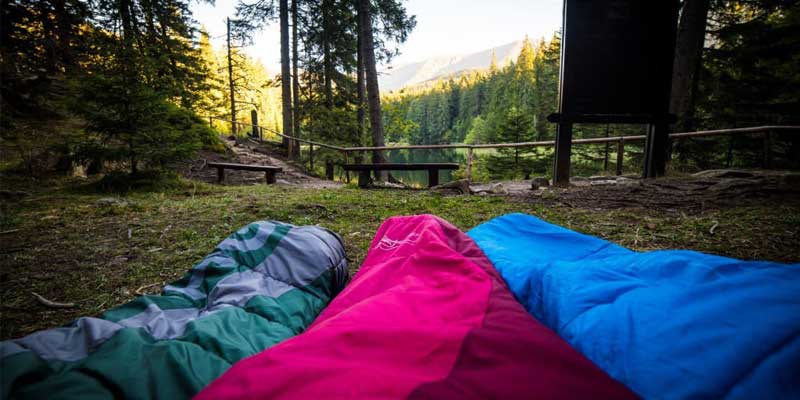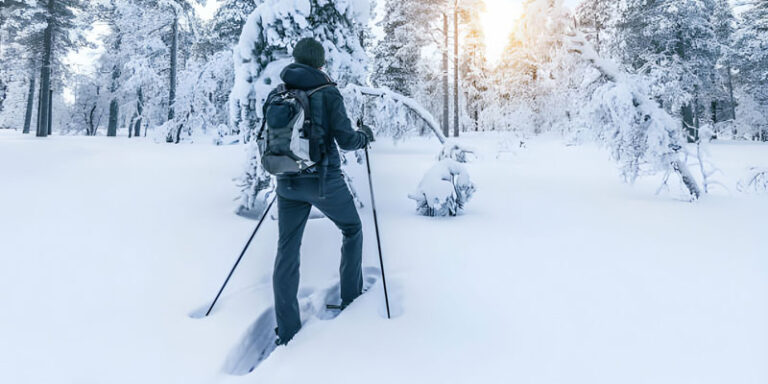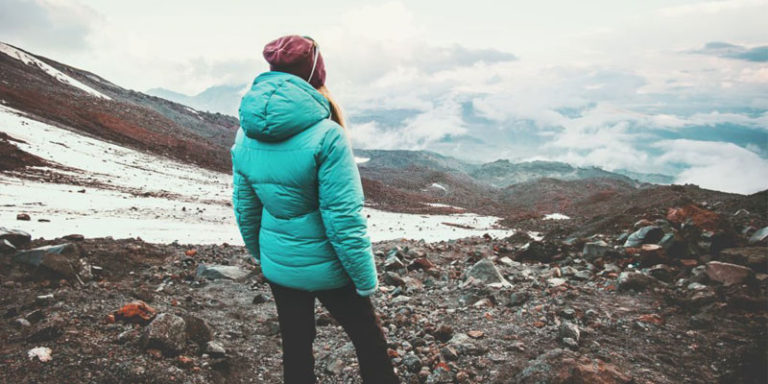When it comes to putting together your sleep system, you will have a decision to make between two main options; a sleeping bag or a quilt. Everyone knows what a sleeping bag is but a quilt may be more of a mystery to some. That’s because quilts are just now coming back into popularity. They’ve been around for decades and decades but only now are they becoming a very popular option for backpackers.
Construction
A sleeping bag features a hood and has insulation on the front, on the sides, and also on the back. Quilts, on the other hand, do not feature a hood and there’s no back insulation. You just have insulation at the feet, on the sides, and the front over your body.
These are the basic differences between a sleeping bag and a quilt but it goes a little bit further than that. With a sleeping bag, you have full protection insulation all the way around you. You typically have a zipper either on the front or on the side. Think of a quilt as being much more minimal. There are no zippers, you have three sides of insulation, and no hood as mentioned before. When it comes to a foot box, some may have one sewn in, some feature snaps, and some may feature a drawcord.
Warmth and Ease of Setup
Sleeping bags will be warmer than your average quilt. With a mummy bag specifically, it forms right next to your body, you don’t have to worry about drafts, and it does keep you warmer. Also, with a sleeping bag, they are much easier to set up. You pull it out of the stuff sack, you throw it out, you put it on top of your sleeping pad, and you’re good to go. That is not the case with a quilt in some situations. Also, sleeping bags tend to have hoods. They have pockets, and draft collars along with the zippers, and some even have sleeping pad attachment points. That feature is still somewhat uncommon with sleeping bags whereas, with quilts, it’s a mainstay feature.
While a quilt offers you more space to move around it’s not as warm as a sleeping bag. Since there is no back to a quilt you, do have to be concerned about drafts. They will happen even with the best sleeping pads. Also, they can be more complicated to set up, especially when you have to attach the quilt to the sleeping pad. This is something that you will have to do in colder conditions but in warmer weather, it’s no big deal.
Most quilts have loops on both sides of the opening and these are attached via a string and that string goes around your sleeping pad holding the quilt in place so that you can toss and turn all night long and you do not get twisted up. It’s a nice feature but again, it’s not perfect because it does take time to set up, and also it is a little bit drafty as you move around. If you’re considering a quilt for your adventures, make sure to get an adequate sleeping pad for your adventures so that you’re not cold.
Weight
Quilts are very lightweight especially when you compare them to your average mummy bag. Not only are they lightweight but they are very compressible and they take up much less space inside of your backpack. They can offer you lots of ventilation and also use options. You can use these in a wider range of temperatures than you can in a sleeping bag. In cold weather, you have it nice and close and tight, and in warm weather, you open it up and just lay it on top of it.
Sleeping bags are heavier than quilts. With most sleeping bags out on the market being mummy-style, you will be more confined than a quilt. You will also get twisted up in it if you toss and turn as I do. I’ve had many mornings where I’ve woken up and I’ve had the sleeping bag absolutely just twisted up and that is something that will happen if you toss and turn as I do. They require more space inside of your backpack and it can’t be more difficult to ventilate legs in a sleeping bag.
Importance of Sleeping Pads
When you lay on a sleeping bag, you compress that fill and that means that it doesn’t keep you as warm as the top layer because it’s the loft of a sleeping bag that keeps you warm. Nonetheless, you do have that material and it does keep you a little bit warm along with a sleeping pad underneath.
With a quilt, things are very much different because you have no back. That means that you are relying 100% on the power the R-value of your sleeping pad to keep you warm. That is a huge difference between these two. Whereas a sleeping bag is a little bit more forgiving in terms of your sleeping pad, a quilt is not forgiving at all. So, if you plan to take a quilt out in cold conditions, you really need to have a top-of-the-line sleeping pad.
Versatility
Quilts offer you quite a bit of versatility that you will not get when your average sleeping bag. Because of the design, it is easier to toss and turn inside of a quilt than a sleeping bag. Some quilts can be used as a top quilt or as a bottom quilt with your hammock, which is very nice. You have that versatility. Now that’s not true with all quilts but there are many quilts out on the market that offer this feature.
Customizations
Another huge Pro of a quilt is that you can have them made to your specifications. It could be as long as you need it, as short as you need it, or it can be as warm as you need it. In other words, you carry with you what you need and not what you don’t. Another huge pro is that you don’t have to worry about any zippers getting caught so no frustrations there. Also, because most quilts are custom-made, you can have them any way that you want to. With any sort of color combination that you want or material or fill it’s your way and that’s pretty nice. That also means you can have a black interior and green exterior if that’s something you want.
Price
In terms of pricing, both can be exceptionally expensive. Sleeping bags have a tendency to be a little bit cheaper though. You should be able to find a good sleeping bag at a cheaper price than a quilt with a similar temperature rating. Quilts can be a little bit more expensive than your average sleeping bag. For money, there are aspects that you need to consider. First off, most quilts are handmade in the United States so there is that aspect whereas most sleeping bags are not made in the United States.
Types of Sleeping Bags
Since we have sleeping bags going head-to-head with quilts, let’s discuss the different types of sleeping bags that are out on the market.
- Mummy Bags go all the way up. You have the hood and you stay nice and snug inside of a mummy bag. With a mummy bag, you tend to stay warmer because you have that insulation right next to your body and skin. Also, because it’s so snug, you’re cutting weight. The biggest con to a mummy bag is that it’s very constrictive. There’s not much space to move around and if you toss and turn it, can get twisted up.
- Rectangular Sleeping Bags offer you plenty of space to sprawl out to move around. You can stretch out your arms, you could stretch out your legs, and generally, they can be completely unzipped and act as a comforter. With these types of sleeping bags, they do not feature a hood.
- Semi-rectangular Sleeping Bags are a cross between the two types of sleeping bags that I’ve mentioned already. You have mummy and rectangular. It’s just a little bit larger in every single way. They offer you more space. They’re a little bit heavier, a little bit less warm but warmer than a rectangular sleeping bag.
Seasons
Now that we’ve talked about the different types of sleeping bags let’s talk about the seasons. There are three main seasons when it comes to a sleeping bag. You have summer, which is 30 degrees and up. You have 3-season bags, which are 15 degrees Fahrenheit to 30 degrees Fahrenheit and you have winter sleeping bags, which are 15 degrees Fahrenheit and below. This classification system also applies to quilts.
Fill
When it comes to a quilt, the main type of fill that you will find is a type of down. While you can’t find some quilts that have synthetic insulation, it is uncommon. When it comes to sleeping bags, both insulations are very common. You have down and you have synthetic. Also, there are all sorts of different variants of those. With both types of insulation, there are pros and cons to consider, and let’s go over those now starting with down.
- Down Fill is very lightweight. It performs very well in the cold. It keeps you very warm. Oftentimes it will feature a water repellent treatment that performs well in wet conditions. It compresses very small but it does feature a longer drying time. Also, it can be extremely expensive, especially for the higher grades of down. One of the biggest negatives or cons when it comes to down, not including the price is that it requires more care. You can’t store it stuffed and you really have to be careful with it so that it continues to loft up whenever you need it and so that it keeps its temperature rating.
- Synthetic Fill in general is very inexpensive. It will keep you warm even when wet and that’s not the case with down in all situations. It is all about that treatment that’s been done to the down itself. Synthetic insulation dries very quickly and requires less care than down, it’s not as warm as down, it’s much heavier though, and also, it doesn’t compress as well as down does. The stuff sack is larger and it will take up more space inside of your backpack whereas down will take up less.
Which one is better?
Between the two options, which is the most popular? Without a doubt, that would be a sleeping bag. There are more styles, materials, and insulation types than what you will find with a quilt. Also, with sleeping bags, you will find a greater degree of temperature ratings than you will with a quilt.
In my personal opinion, both are great and both have their own pros and cons. For the warmer months, nothing beats a quilt. Nothing beats that versatility of being able to wrap up when you’re cold or to just pull it off of you when you’re not. You can have it nice and loose on those warm nights or again, nice and tight on the cold ones.
But when it gets colder, I want a mummy sleeping bag generally below 25 degrees. I stay warmer and I don’t have to worry about the drafts. Generally, on cold nights, I sleep better with a sleeping bag than I do a quilt. For me, those are my preferences in regards to my sleep systems.
So which one wins? In my opinion, neither. It’s all about using the right tool for the job and the right piece of equipment at the right time. Do keep in mind that everyone’s preferences are different. Mine may not apply to you but for myself, quilts for warm weather sleeping bags for cold weather.



